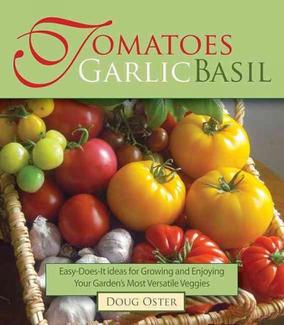No food grower’s garden is worth its salt without a glorious bounty of tomatoes, and they taste even better with a pinch of salt! This is ironic, as botanically a tomato is a fruit – ie a seed bearing ovary. More commonly used as a vegetable, tomatoes are a mainstay of savoury dishes around the world. In pasta sauces and pizzas, salsas and soups, or raw in salads, sun-dried in oil or even combined with alcohol for a Bloody Mary – tomatoes are an essential part of our diet the world over.
Originating in South America, tomatoes were spread around the world after the Spanish conquered the Americas in the early 16th Century. Searching for gold, the conquistadores uncovered an unexpected and precious crop in the tomato. In 1544, in the first mention of the tomato in European literature, it was named pomo d’oro, or “golden apple” by Pietro Andrea Mattioli, an Italian botanist. Initially tomatoes were used in Florence for elaborate table decoration. A member of the ‘nightshade’ family, there was a belief that the fruit was poisonous, until the early 18th Century when it became a staple of Italian cuisine. Well ripened tomatoes are non-toxic, and in fact they are rich in antioxidants, and are extremely beneficial to your health.
Hybrids or Heirlooms?

Home grown tomatoes are universally popular, both to grow and to eat, as they are small enough for any space and are relatively easy to grow, especially in pots which can be moved around to suit the availability of sunlight and make best use of space. Fresh home grown tomatoes taste much more delicious than commercial tomatoes. They come in many shapes and sizes, from small juicy cherry varieties through to large beefsteak tomatoes, and in both heirloom (known as heritage in the UK) and hybrid varieties. Heirloom tomatoes are breeds that grow from open pollination – by natural means like birds, insects and wind, and that have ‘true-bred’ for at least forty years. Heirloom tomato plants with the same inheritable traits or ‘phenotype’ breed ‘true’, and do not cross pollinate with other tomato plants, so both sides of the plant’s DNA are identical .
Cross pollination produces hybrid tomato varieties. Often this is done for commercial purposes to breed plant strains that withstand commercial storage or transportation, for example. Heirloom tomatoes are becoming increasingly more popular with organic home gardeners. They are not limited to the usual red colour – but come in green, purple, yellow, orange, and can even be striped.
Though they are less disease resistant than hybrid varieties grown for commercial use, home gardeners can spend more time ensuring their tomatoes are free from disease. They also tend to produce less fruit than hybrid plants, but as tomatoes are an abundant crop this will not be a problem for individual gardeners. And the upside is they are very often far more tasty than the commercial hybrids.
Growing Conditions
If you have never grown vegetables, tomatoes are a good place to start. The secret to good growth is lots of sunlight (preferably 5 – 7 hours per day), lots of watering in warm weather, and weekly feeding with a high-potash tomato feed. You can grow tomatoes from seed with little difficulty if you have the room, or buy them as young seedlings from a reputable local nursery. Pick strong, sturdy looking plants. Good, full roots provide good flowers, which in turn produce abundant fruit.
Tomatoes like warm, well drained soil. When growing plants outdoors, pick a sunny spot beside a wall as it will provide necessary mid day shade as well as support. Water the plant inside its plant pot so the soil sticks together, then take it out and place in the earth, firm down with fresh soil and water well. Fertilizer is not necessary in the hole as, particularly if nitrogen rich, it encourages leaf growth at the expense of fruit. Tomatoes thrive on potash however – add a pinch of sulphate of potash to induce early flowering, and to keep the leaves healthy. Add a potash rich feed weekly as the plants grow for lovely tasting fruit. Instead of mulching, agricultural plastic cut around the base of the plants keeps the soil nice and warm. In temperate climates, you can even make a little ‘greenhouse’ by staking your plants, and tying clear plastic to the stakes, and over your plants. This will protect them from cold nights.
Always choose tomato plants which are suited to your climate. For example, as the name suggests, Siberia‘ is a good cool weather variety, as is the interestingly shaded Black Russian; Moneymaker is a good all round tomato for a moderate climate; Burnley Gem sets well in hot, dry climates, and Marmand and Tropic both thrive in hot, southern Mediterranean climates. When placing tomato plants outside, make sure the danger of frost has passed. Thriving at about 15C/60F, tomato plants will be fine at up to about 30 degrees Celsius (or roughly 80 degrees Fahrenheit), though they can withstand higher temperatures for shortish periods, if given shade.
Growing Tomatoes from Seed
To grow your tomatoes from seed, firstly – source the seed! If you want to grow heirloom varieties, you can successfully grow your plants using seed from a ripe heirloom tomato, mashed into a jar half filled with water and allowed to decompose over 1 – 6 days. When the seeds sink to the bottom, rinse them and dry them. When clean and dry they are easier to separate, and dry seeds will germinate more effectively. Otherwise, buy your seeds in packets. In Australia Diggers club or Eden Seeds are both good places to buy heirloom seeds online.
Sow seeds inside in early spring, two months before the last frost date, unless you are growing in a greenhouse, where you can sow from late winter. Fill a 7.5cm (3″) pot with compost, press down lightly and water. Scatter seeds thinly and place to germinate on a warm windowsill (at about 18C/65F). Seedlings will show in about a fortnight, and be large enough to put in individual 3″ pots in eight weeks. To do this, make a hole in the soil and carefully place in the seedling, cover the roots and firm gently, then water. When roots appear through the drainage holes, transplant the seedlings to 12cm (5″) pots. Once planted or placed outside in pots, it takes about two months from flowering to fruit.
Particulars for Tomatoes in Pots
 Many bugs and diseases that live in soil are prevented from attacking tomatoes grown in pots. To grow a tall, ‘indeterminate’ variety in a pot, make sure it’s at least 9″ in diameter. Stake the main shoot or cordon with canes for support and pinch out side shoots to discourage side growth – these grow from the main stem at the leaf joints. Remove the top of the main stem above the fourth flower truss.
Many bugs and diseases that live in soil are prevented from attacking tomatoes grown in pots. To grow a tall, ‘indeterminate’ variety in a pot, make sure it’s at least 9″ in diameter. Stake the main shoot or cordon with canes for support and pinch out side shoots to discourage side growth – these grow from the main stem at the leaf joints. Remove the top of the main stem above the fourth flower truss.
Place pots in a sunny spot, but if it gets very hot, remove to partial shade. Pots dry out more quickly than garden soil, so water your tomatoes well in warm, dry weather, though be careful not to overwater if it is very humid. Tomatoes require regular watering, as drying out encourages thickening of tomato skin, followed by swelling and splitting once you water again. Blossom end rot can set in with irregular watering, which makes the tomatoes inedible.
Adding sharp sand, also known as builders sand, to the bottom of large pots adds drainage as well as weight in windy weather. Limit drainage holes, or water will drain straight through. Remove lower leaves to stop water splashing on them, which could encourage infections. Don’t water with cold water – let it warm up to air temperature, or add a little warm water to cold tap water.
Growing Cherry Tomatoes
The ‘dwarf’ bush tomato or cherry tomato, has a smaller fruit than regular salad tomatoes and was especially developed for pots and hanging baskets. Often called ‘determinate’ plants, these small bush-type plants do not need their side shoots pinching out as they are compact, and also easier to grow from seed. They require less (if any) staking.
Growing cherry tomatoes is becoming increasingly popular. They ripen early, they taste sweet and they need little space. As they have less growing to do, they are successful in cooler climates and ripen sooner than larger varieties. They are very pretty tumbling out of pots in a small area like a balcony or window box. The ‘Cherry Tomato Tumbler’ is great for a hanging basket, and has lovely sweet fruit. You must water hanging baskets frequently as they are exposed to the air, and heat up and dry out quickly. Good cherry ‘bush’ varieties include Bullseye, Minibel, Micro Tom or Hardy Tom, and Sprite. Good ‘cordon’ or tall, indeterminate varieties include Sungella, Sungold and Tommy Toe.
To grow several cherry tomato plants together, put them in large pots, at least 38cm (15″) across to avoid overcrowding. Even better – plant them with companion plants, like parsley or sweet basil.
Companion Planting
Strong scented plants like French marigolds, alliums (onions, garlic and chives) and mints, (basil, spearmint and oregano), can mask the scent of tomato plants, making it harder for pests like whitefly to locate them, and may confuse them into landing on the wrong plant! Borage is thought to repel the tomato hornworm moth, and parsley and dill also provide nectar for an adult parasitic wasp whose larvae eats the hornworm. These plants also attract predatory flies that attack tomato pests, as well as providing shade in very hot weather when planted together with tomatoes in pots.
In very humid conditions, spray your tomato plants with an organic fungicide to prevent blight.


